- The tree above and
below the ground
Remember when drawing up your tree planting plan that there is at least as much tree under the ground as above it and that the roots spread out beyond the drip line.
For healthy tree growth above ground, the underground parts of the tree need enough space to feed, drink and breathe.
|
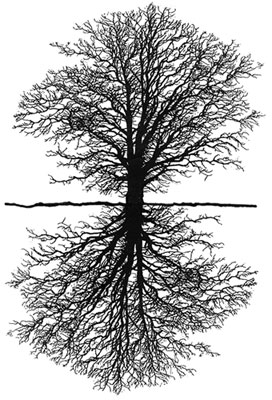 |
- Root growth and
feeding
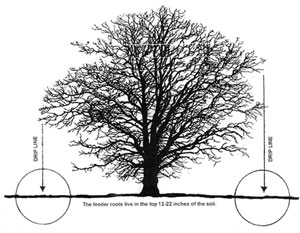 The feeder roots of a tree live in the top 12-22 inches of the soil. The most intensive feeding takes place in the top 12-22 inches of soil at the drip line. Make sure that the feeder roots of your trees have the best possible home to live in by protecting the soil from compaction and erosion from the trunk of the tree to the drip line in established trees. For newly-planted small trees, extend the planting space for several feet beyond the drip line and plan to continue to enlarge the space over time as the tree grows. Feeder roots are sensitive to the many feet in schoolyards treading the surface of the ground above them and are unlikely to grow where they feel this pressure.
The feeder roots of a tree live in the top 12-22 inches of the soil. The most intensive feeding takes place in the top 12-22 inches of soil at the drip line. Make sure that the feeder roots of your trees have the best possible home to live in by protecting the soil from compaction and erosion from the trunk of the tree to the drip line in established trees. For newly-planted small trees, extend the planting space for several feet beyond the drip line and plan to continue to enlarge the space over time as the tree grows. Feeder roots are sensitive to the many feet in schoolyards treading the surface of the ground above them and are unlikely to grow where they feel this pressure.
When the soil close to a tree is as hard as
concrete or is smothered by non-porous material, it becomes deprived of
water, air and nutrients. The soil organisms necessary for maintaining
the soil in good health cannot live under paving because they also
require water, air and food.
- Preparing the
planting site
Remove the sod and break up the ground to a depth of about two feet particularly in compacted soil and where clay or a mixture of clay and shale is encountered. The sod can be mixed in with the broken up soil or placed upside down on the surface of the broken up area. In heavier or stonier soils it may be necessary to remove some of the existing soil and mix it with about one-third of new top soil. The planting space for a single tree should measure approximately 10' X 10'.
Make a mound of top soil about one foot high in the centre and taper it towards the edges of the planting space.
Dig a planting hole in the mound and plant the tree. Build up a ring of soil around the edge of the root ball to make a bowl-shaped space for catching water.
Cover the entire area with a four-inch layer of mulch such as wood chips to help retain moisture in the soil, protect it from trampling and prevent erosion.
- Planting single
trees at grade
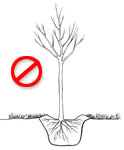 The survival rate is very low for single trees planted at grade level in schoolyards, particularly in open areas such as sports fields and in other active or exposed spaces. The planting method shown in this diagram is fine for front yards or for sheltered spaces away from children at play; however, it is not recommended for most schoolyards. With no grade separation to constantly serve as a reminder about the need to protect trees from physical damage, children often lean bicycles against the tree, swing around the stem and hang bags and jackets on the branches while playing in the yard.
The survival rate is very low for single trees planted at grade level in schoolyards, particularly in open areas such as sports fields and in other active or exposed spaces. The planting method shown in this diagram is fine for front yards or for sheltered spaces away from children at play; however, it is not recommended for most schoolyards. With no grade separation to constantly serve as a reminder about the need to protect trees from physical damage, children often lean bicycles against the tree, swing around the stem and hang bags and jackets on the branches while playing in the yard.
Where trees are planted directly in the grass,
mowers attempt to mow as close to the stem as possible which places the
trees at risk from both mechanical injury and soil compaction.
- Planting groves of
trees
Creating tree spaces or groves of trees as designated quiet areas helps trees survive the unfavorable growing conditions of many school grounds. Planting large groupings of trees improves the general growing conditions in the soil around the trees. Also, several smaller trees planted in one location are more visible and, therefore, better protected from accidental damage from children at play than several smaller trees planted singly in separate locations on the grounds.
The preparation of the planting site for a grove of trees is very similar to that of planting one tree in a mound (see diagram 3.) the main difference being that it will be on a much larger scale and with the addition of pathways and spaces for seating areas between the mounds. The soil within the entire grove should be broken up and mixed with organic matter before shaping the mound.
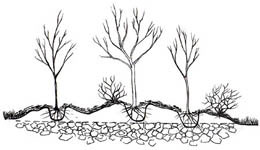 As shown in the diagram, swales or shallow depressions in the mounds of soil around the trees catch rainwater and help prevent it from running off the mounds before it can soak into the soil.
As shown in the diagram, swales or shallow depressions in the mounds of soil around the trees catch rainwater and help prevent it from running off the mounds before it can soak into the soil.
A four-inch layer of mulch such as wood chips can be spread over the entire area to help retain moisture in the soil, reduce weeds, and protect the soil from erosion. The mulch can be raked off small areas of the soil when new plants such as shrubs, perennials and ground covers are added.
- Planting on a
slope
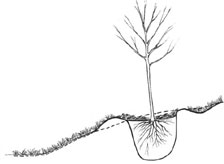 Trees planted on slopes often grow poorly because
of the dry conditions created when water runs off before it has time to
soak into the soil. Water can be prevented from running off by creating
a shallow swale the length of the planting area up-slope from the tree.
In addition, water can be held back by making a small hump along the
length of the planting space a little down-slope from the tree.
Trees planted on slopes often grow poorly because
of the dry conditions created when water runs off before it has time to
soak into the soil. Water can be prevented from running off by creating
a shallow swale the length of the planting area up-slope from the tree.
In addition, water can be held back by making a small hump along the
length of the planting space a little down-slope from the tree.
- Stakes and tree
guards
Stakes should both act as a support and allow for growth. Stakes should permit a certain amount of trunk movement rather than attempting to hold the tree in one position.
For larger trees (45-65 mm trunk diameter), use two to three stakes per tree until the roots have become established and can support the tree against strong winds. For smaller trees (25-40 mm trunk diameter), place one stake downwind from the tree so that the prevailing winds blow the tree towards the stake. If the stake is placed on the upwind side of the tree, strong winds blowing the tree in the opposite direction from the stake could snap the tree.
The movement of the trunk by the wind stimulates the root system to form in a way that anchors the tree so that it can grow to withstand the wind. Over-staking the tree may retard the development of the tree's own self-support system.
Check the stakes periodically to make sure that the tree is not held too tightly. Stakes should be removed after a few growing seasons.
To prevent rodent damage over the Winter months, tree wraps or guards should be placed to a height of about two feet around the base of the stems of younger trees until the thicker, rougher bark has developed. Make sure that the wrap has sufficient air holes to prevent moisture from being trapped between the wrap and the stem. The wrap should be removed in the Spring and replaced in the Fall. As an alternative, you can wrap metal mesh around the base of the tree. The mesh can be left in place year round until the bark has developed.